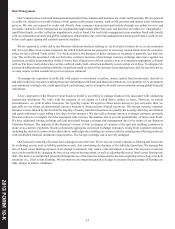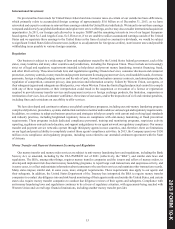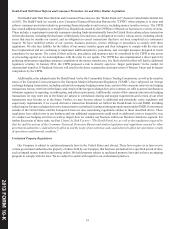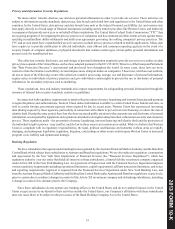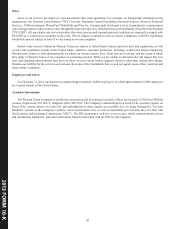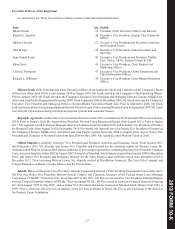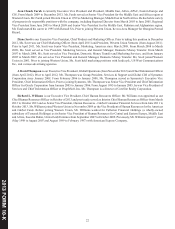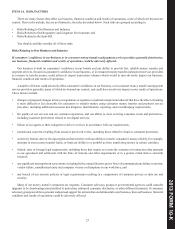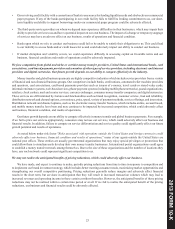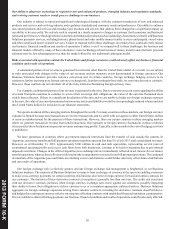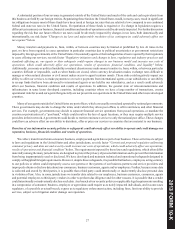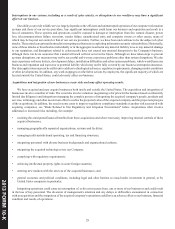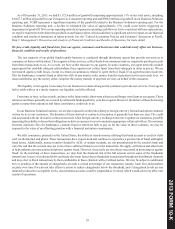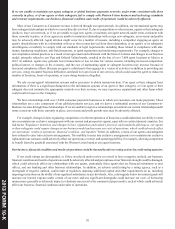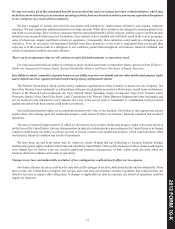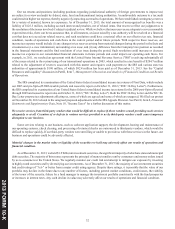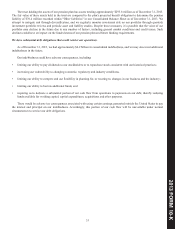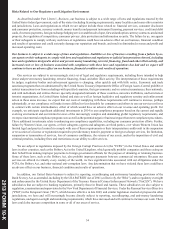Western Union 2013 Annual Report Download - page 134
Download and view the complete annual report
Please find page 134 of the 2013 Western Union annual report below. You can navigate through the pages in the report by either clicking on the pages listed below, or by using the keyword search tool below to find specific information within the annual report.
2013 FORM 10-K
24
Global economic downturns or slower growth or declines in the money transfer, payment service, and other markets in which
we operate, including those related to interruptions in migration patterns, and difficult conditions in global financial markets
and financial market disruptions could adversely affect our business, financial condition and results of operations.
The global economy has experienced in recent years, and in the future may experience, downturns, volatility and disruption,
and we face certain risks relating to such events, including:
• Demand for our services could soften, including due to low consumer confidence, high unemployment, or reduced global
trade.
• Our Consumer-to-Consumer money transfer business relies in large part on migration, which brings workers to countries with
greater economic opportunities than those available in their native countries. A significant portion of money transfers are sent
by international migrants. Migration is affected by (among other factors) overall economic conditions, the availability of job
opportunities, changes in immigration laws, and political or other events (such as war, terrorism or health emergencies) that
would make it more difficult for workers to migrate or work abroad. Changes to these factors could adversely affect our
remittance volume and could have an adverse effect on our business, financial condition and results of operations.
• Many of our consumers work in industries that may be impacted by deteriorating economic conditions more quickly or
significantly than other industries. Reduced job opportunities, especially in retail, healthcare, hospitality, and construction, or
overall weakness in the world’s economies could adversely affect the number of money transfer transactions, the principal
amounts transferred and correspondingly our results of operations. If general market softness in the economies of countries
important to migrant workers occurs, our results of operations could be adversely impacted. Additionally, if our consumer
transactions decline, if the amount of money that consumers send per transaction declines, or if migration patterns shift due
to weak or deteriorating economic conditions, our results of operations may be adversely affected.
• Our agents or clients could experience reduced sales or business as a result of a deterioration in economic conditions. As a
result, our agents could reduce their numbers of locations or hours of operation, or cease doing business altogether. Businesses
using our services may make fewer cross-currency payments or may have fewer customers making payments to them through
us, particularly businesses in those industries that may be more affected by an economic downturn.
• Our exposure to receivables from our agents, consumers and businesses could impact us. For more information on this risk,
see risk factor, "We face credit, liquidity and fraud risks from our agents, consumers and businesses that could adversely affect
our business, financial condition and results of operations."
• The market value of the securities in our investment portfolio may substantially decline. The impact of that decline in value
may adversely affect our liquidity, results of operations and financial condition.
• The counterparties to the derivative financial instruments that we use to reduce our exposure to various market risks, including
changes in interest rates and foreign exchange rates, may fail to honor their obligations, which could expose us to risks we
had sought to mitigate. That failure could have an adverse effect on our financial condition and results of operations.
• We aggregate our foreign exchange exposures in our Business Solutions business, including the exposure generated by the
derivative contracts we write to our customers as part of our cross-currency payments business, and typically hedge the net
exposure through offsetting contracts with established financial institution counterparties. If our customers fail to honor their
obligations or if the counterparties to our offsetting positions fail to honor their obligations, our business, financial condition
and results of operations could be adversely affected.
• We may be unable to refinance our existing indebtedness as it becomes due or we may have to refinance on unfavorable terms,
which could require us to dedicate a substantial portion of our cash flow from operations to payments on our debt, thereby
reducing funds available for working capital, capital expenditures, acquisitions, share repurchases, dividends, and other
purposes.
• Our revolving credit facility with a consortium of banks is one source for funding liquidity needs and also backs our commercial
paper program. If any of the banks participating in our credit facility fails to fulfill its lending commitment to us, our
term liquidity and ability to support borrowings under our commercial paper program could be adversely
• The third-party service providers on whom we depend may experience ficulties in their businesses, which may impair their
ability to provide services to us and have a potential impact on our own business. The impact of a change or temporary stoppage
of services may have an adverse fect on our business, results of operations and financial
• Banks upon which we rely to conduct our business could fail or be unable to satisfy their obligations to us. This could lead
to our inability to access funds and/or credit losses for us and could adversely impact our ability to conduct our
• If market disruption and volatility occurs, we could experience ficulty in accessing capital on favorable terms and our
business, financial condition and results of operations could be adversely
Money transfer and global business payments are highly competitive industries which include service providers from a variety
of financial and non-financial business groups. Our competitors include banks, credit unions, automated teller machine providers
and operators, card associations, card-based payments providers such as issuers of , travel cards or stored-value cards,
informal remittance systems, web-based services, phone payment systems (including mobile phone networks), postal ganizations,
retailers, check cashers, mail and courier services, currency exchanges, consumer money transfer companies, and digital currencies.
These services are ferentiated by features and functionalities such as brand recognition, customer service, trust and ,
distribution network and channel options, convenience, price, speed, variety of payment methods, service ferings, and innovation.
Distribution network and channel options, such as the electronic money transfer business, which includes online, account based,
and mobile money , have been and may continue to be impacted by increased competition, which could adversely fect
our business, financial condition, and results of
Our future growth depends on our ability to compete fectively in money transfer and global business payments. For example,
if we fail to price our services , consumers may not use our services, which could adversely fect our business and
financial results. In addition, failure to compete on service ferentiation and service quality could significantly fect our future
growth potential and results of operations.
As noted below under risk factor
many of our agents outside the United States are
national post fices. These entities are usually governmental ganizations that may enjoy special privileges or protections that
could allow them to simultaneously develop their own money transfer businesses. International postal ganizations could agree
to establish a money transfer network among themselves. Due to the size of these ganizations and the number of locations they
have, any such network could represent significant competition to us.
e have made, and expect to continue to make, periodic pricing reductions from time to time in response to competition and
to implement our brand investment , which includes better meeting consumer needs, maximizing market opportunities and
strengthening our overall competitive positioning. Pricing reductions generally reduce gins and adversely fect financial
results in the short term, but are done in anticipation that they will result in increased transaction volumes which may lead to
increased revenues and operating income in these certain corridors . , the anticipated benefits of these pricing
reductions may not be realized within a certain time period or at all. If we fail to realize the anticipated benefit of the pricing
reductions, our business and financial results could be adversely


